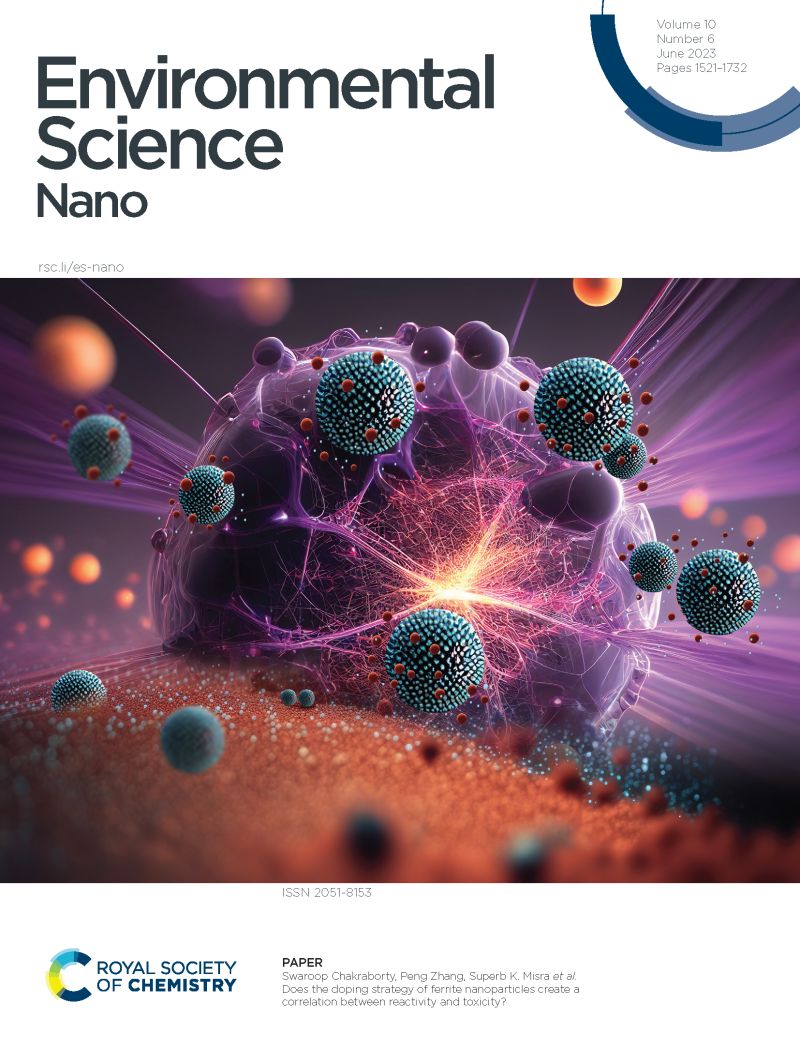Unparalleled photocurrent and dark radical conversions of natural nano-iron oxides versus synthetic ones: thousand-fold enhanced degradation of extra antibiotic resistant genes
IF 5.8
2区 环境科学与生态学
Q1 CHEMISTRY, MULTIDISCIPLINARY
引用次数: 0
Abstract
Antibiotic resistant genes (ARGs) have been widely detected in global rivers, lakes and oceans. Although nanoscale natural acrisol iron oxides (NNIOs) are ubiquitous in global aquatic environments, their photoelectric conversion efficiency and bactericidal and ARG removal are not well clarified. This study evaluated the photocurrent conversion and photocatalytic degradation of antibiotic-resistant bacteria and extracellular ARGs (eARGs) of two typical NNIOs (natural hematite and goethite) in comparison with their synthetic ones. It was found that NNIOs exhibit unparalleled and persistent photocurrent conversion versus the synthetic ones. NNIOs also had high dark radical conversion in contrast to little conversion of the synthetic ones. Owing to these unrivalled performance, NNIOs had significant advantages of killing bacteria over the synthetic ones. What is more important, thousand-fold higher degradation rates of eARGs were obtained by NNIOs than the synthetic ones under light or light–dark conditions. The residual eARG copies after synthesized hematite treatment were up to 17 400 times that of natural hematite groups, and this difference between synthetic and natural goethite was 1612 times. These novel findings imply that enough attention should be paid to the overlooked huge contribution of NNIOs to aquatic eARG elimination and reduction of antibiotic resistance risk. The mechanisms of incomparable photoelectric and dark radical conversions of NNIOs and their ultraefficient degradation of eARGs deserve further study.

天然纳米氧化铁与合成氧化铁的无与伦比的光电流和暗自由基转化:对额外的抗生素抗性基因的降解增强了数千倍
抗生素耐药基因(ARGs)已在全球河流、湖泊和海洋中广泛发现。虽然纳米级天然烯丙醇氧化铁(NNIOs)在全球水生环境中普遍存在,但其光电转换效率以及杀菌和去除ARG的能力尚未得到很好的阐明。本研究比较了两种典型NNIOs(天然赤铁矿和针铁矿)的耐药菌和光催化降解的光电流转换和细胞外ARGs (eARGs)。研究发现,nnio与合成nio相比,具有无与伦比的持久光电流转换特性。NNIOs具有较高的暗自由基转化率,而合成nios的暗自由基转化率较低。由于这些无可比拟的性能,nnio具有比合成nio更显著的杀菌优势。更重要的是,在光照或明暗条件下,NNIOs对eggs的降解率比合成的高数千倍。合成赤铁矿处理后的残余eARG拷贝数是天然赤铁矿组的17 400倍,与天然针铁矿组的差异为1612倍。这些新发现表明,我们应该足够重视NNIOs在消除水生eARG和降低抗生素耐药风险方面被忽视的巨大贡献。NNIOs无与伦比的光电和暗自由基转化及其超高效降解eARGs的机制值得进一步研究。
本文章由计算机程序翻译,如有差异,请以英文原文为准。
求助全文
约1分钟内获得全文
求助全文
来源期刊

Environmental Science: Nano
CHEMISTRY, MULTIDISCIPLINARY-ENVIRONMENTAL SCIENCES
CiteScore
12.20
自引率
5.50%
发文量
290
审稿时长
2.1 months
期刊介绍:
Environmental Science: Nano serves as a comprehensive and high-impact peer-reviewed source of information on the design and demonstration of engineered nanomaterials for environment-based applications. It also covers the interactions between engineered, natural, and incidental nanomaterials with biological and environmental systems. This scope includes, but is not limited to, the following topic areas:
Novel nanomaterial-based applications for water, air, soil, food, and energy sustainability
Nanomaterial interactions with biological systems and nanotoxicology
Environmental fate, reactivity, and transformations of nanoscale materials
Nanoscale processes in the environment
Sustainable nanotechnology including rational nanomaterial design, life cycle assessment, risk/benefit analysis
 求助内容:
求助内容: 应助结果提醒方式:
应助结果提醒方式:


